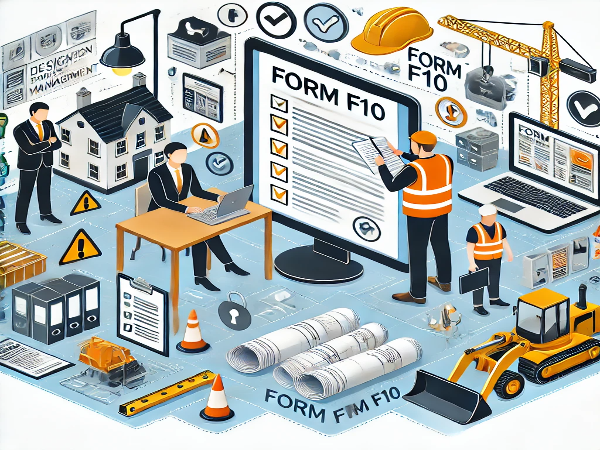Who Issues the Form F10 Certificate? Understanding the Key Responsibilities and Legal Compliance in UK Construction
A Comprehensive Guide to Form F10 and Its Role in Construction Safety and Legal Compliance under CDM 2015

In the context of UK construction, who issues the Form F10 certificate is a crucial question for project stakeholders to ensure compliance with the Construction (Design and Management) Regulations 2015 (CDM 2015). The Form F10 is a notification form that must be submitted to the Health and Safety Executive (HSE) by the client before the construction phase of a project begins. It is required for projects that meet certain thresholds related to duration, workforce size, or person-days of work. By understanding the responsibilities involved in issuing the F10, clients, contractors, and other stakeholders can avoid legal penalties and ensure the safety of both workers and the public throughout the lifecycle of a project.
Introduction
The construction industry in the United Kingdom operates within a stringent regulatory framework, designed to protect the health and safety of workers, the public, and the environment. One of the essential safety documents required under UK law is the Form F10. This form, governed by the Construction (Design and Management) Regulations 2015 (CDM 2015), plays a critical role in notifying the Health and Safety Executive (HSE) about significant construction projects. For construction projects that meet certain criteria, understanding who issues the Form F10 certificate is vital to ensure legal compliance and avoid costly penalties.
This article delves into the specifics of the Form F10, its requirements, and the parties involved in its submission. By the end of this guide, you will gain a clear understanding of when, why, and by whom the F10 certificate is issued in the construction industry.
What Is the Form F10 Certificate?
The Form F10 is a notification form required by the Health and Safety Executive (HSE) under the Construction (Design and Management) Regulations 2015 (CDM 2015). This form must be submitted before the commencement of a construction project to inform the HSE of key details related to the project’s scope, timeline, and risks. It helps the HSE monitor and enforce health and safety standards on construction sites.
Form F10 is necessary for projects that involve substantial workforces or long durations. The goal of this notification is to ensure that high-risk projects are adequately planned and managed from a safety perspective. It’s a legal requirement that ensures all parties involved in a construction project are aware of the safety protocols in place before the physical work begins.
Who Is Responsible for Issuing the Form F10 Certificate?
One of the most commonly asked questions related to Form F10 is: who issues the form F10 certificate? The answer is that it is the responsibility of the client to submit the Form F10 notification. In the context of construction projects, the client refers to the individual or organization that commissions and funds the project.
The client has the duty to ensure that the correct safety procedures are followed and that the HSE is notified of the project before any construction activities commence. This responsibility is crucial as failure to submit the Form F10 on time can lead to significant legal repercussions, including fines or project delays.
In cases where the client is unable to fulfill this responsibility, the principal contractor or principal designer may take on the task of submitting the F10 form. However, the ultimate responsibility rests with the client.
When Is the Form F10 Notification Required?
The Form F10 notification is not required for every construction project. It is necessary only when specific conditions are met. These include:
Duration and Workforce Size
If a construction project is expected to last more than 30 working days and will have 20 or more workers on site at the same time, the Form F10 notification must be submitted to the HSE.
Total Person-Days of Work
If a project involves more than 500 person-days of construction work in total, the Form F10 is required. A person-day refers to one person working for one day. This condition is set to ensure that larger, more complex projects with higher safety risks are properly monitored.
Other Complex Projects
In some cases, even if a project does not meet the above criteria, the HSE may still require the Form F10 if the project is deemed to present significant risks to health and safety. For example, projects involving unusual construction methods or hazardous materials may require notification regardless of their duration or workforce size.
Consequences of Failing to Submit the Form F10
Failure to submit the Form F10 when required can lead to severe consequences for those involved in the project. These include:
Legal Penalties
Non-compliance with the Form F10 notification requirement is a breach of CDM 2015 regulations. The HSE can impose heavy fines on the client or contractor for failing to notify them of the project in a timely manner. In some cases, individuals may even face criminal charges if safety standards are not followed.
Project Delays and Suspension
If the Form F10 is not submitted before the construction phase begins, the HSE can suspend the project until the necessary notification is made. This can cause delays, disruption, and potential cost overruns.
Increased Risk of Accidents
Without proper notification and oversight, there is a higher risk of accidents and health issues arising during the construction phase. The Form F10 ensures that the project is adequately planned, with appropriate safety measures in place, to reduce these risks.
How to Submit the Form F10 Notification
Submitting the Form F10 is relatively straightforward, but it requires accurate and detailed information about the construction project. The following steps outline the process:
Gather Project Details
Before filling out the form, ensure you have all the relevant details about the project, including:
- The project’s expected start and end dates.
- The estimated number of workers and the maximum number of people on-site at one time.
- A description of the project scope and its associated risks.
- The name and contact details of the principal contractor and designer.
Complete the Form F10
The Form F10 can be completed online through the HSE website. It will require you to fill in details about the project, including its duration, workforce size, and health and safety measures in place.
Submit the Form to the HSE
Once the form is completed, submit it to the HSE electronically. It is important to ensure that the form is submitted well in advance of the construction phase, as late submissions can result in legal penalties.
Keep Records
After submission, retain a copy of the confirmation and the form for your records. This will serve as evidence of compliance should the HSE request it at any point during the project.
Best Practices for Ensuring Compliance
To ensure the Form F10 is submitted correctly and on time, follow these best practices:
Assign Responsibility Early
Designate a competent person, such as a project manager or the principal contractor, to handle the F10 submission process. This ensures that the responsibility is clearly defined and that the form is submitted promptly.
Submit the Notification Early
Do not wait until the last minute to submit the required notification. Make sure to submit it well before the construction phase begins to avoid potential delays or penalties.
Stay Informed of Regulatory Changes
The construction industry is subject to evolving safety regulations. Keep up to date with any changes to the CDM 2015 regulations or HSE requirements to ensure continued compliance.
Conclusion
In summary, understanding who issues the notification certificate and the associated responsibilities is crucial for ensuring that a construction project in the UK meets the necessary legal and safety requirements. The client is primarily responsible for submitting the required notification, and it must be done before the construction phase begins if the project meets certain criteria related to size, duration, and complexity. By following the regulations outlined in the CDM 2015, project stakeholders can ensure safety, avoid legal issues, and contribute to the overall success of the project.



